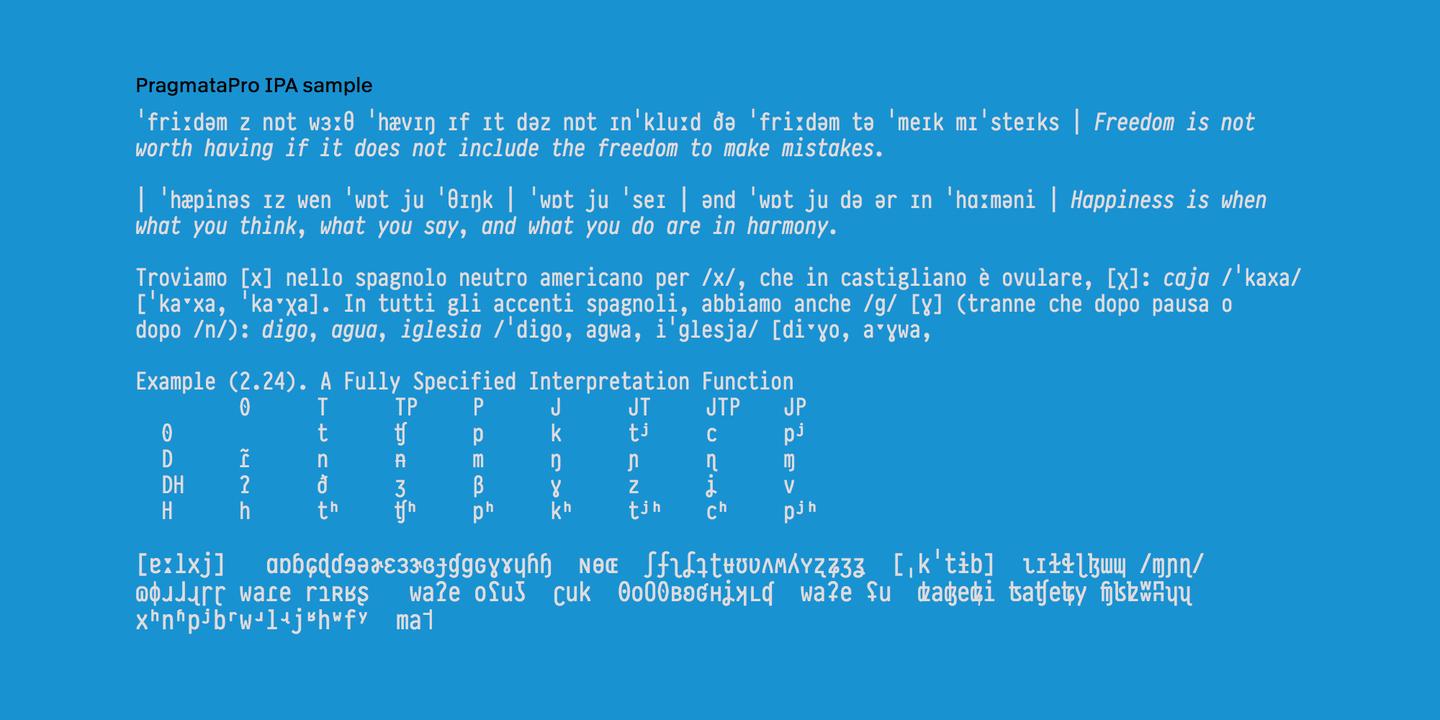

Glyphs in stylistic sets may be designed to harmonise visually, interract in particular ways, or otherwise work together. multiple variants for lowercase letters in a Latin font. 'ss20' provide a mechanism for glyphs in these sets to be associated via GSUB lookup indexes to default forms and to each other, and for users to select from available stylistic sets.įunction: In addition to, or instead of, stylistic alternatives of individual glyphs (see 'salt' feature), some fonts may contain sets of stylistic variant glyphs corresponding to portions of the character set, e.g.
#Pragmata pro for free#
Individual features numbered sequentially with the tag name convention 'ss01' 'ss02' 'ss03'. I designed PragmataPro typeface and I want to offer it for free to al Check out PragmataPro, the ideal programming typeface, open source on Indiegogo. Examples of fonts including stylistic sets are Zapfino Linotype and Adobe's Poetica.

In Caflisch Script, o is replaced by o.alt2 when followed by an ascending letterform.įunction: In addition to, or instead of, stylistic alternatives of individual glyphs (see 'salt' feature), some fonts may contain sets of stylistic variant glyphs corresponding to portions of the character set, e.g.

Used in script typefaces which are designed to have some or all of their glyphs join. The application can use this feature to automatically access the superior figures (more legible than scaled figures) for footnotes, or the user can apply it to Mssr to get the classic form.įunction: In specified situations, replaces default glyphs with alternate forms which provide better joining behavior. The font implements Unicode characters, including (polytonic) Greek, 2 Cyrillic, Arabic, Hebrew and the APL codepoints. 1 It is a narrow programming font designed for legibility. The application can use this feature to automatically access the inferior figures (more legible than scaled figures).įunction: Replaces lining or oldstyle figures with superior figures (primarily for footnote indication), and replaces lowercase letters with superior letters (primarily for abbreviated French titles). PragmataPro is a monospaced font family designed for programming, created by Fabrizio Schiavi. May also replace lowercase characters with alphabetic inferiors. The user applies this feature to text to enable localized Bulgarian forms of Cyrillic letters alternatively, the feature might enable localized Russian forms in a Bulgarian manufactured font in which the Bulgarian forms are the default characters.įunction: Replaces lining or oldstyle figures with inferior figures (smaller glyphs which sit lower than the standard baseline, primarily for chemical or mathematical notation). This feature enables localized forms of glyphs to be substituted for default forms. In some cases the localized form differs only subtly from the script 'norm', in others the forms are radically distinct. For example, a number of letters in the Bulgarian and Serbian alphabets have forms distinct from their Russian counterparts and from each other. The user enters 3/4 in a recipe and gets the threequarters fraction.įunction: Many scripts used to write multiple languages over wide geographical areas have developed localized variant forms of specific letters, which are used by individual literary communities. In the string 11/17 selected by the user, the application turns the 17 into denominators when the user applies the fraction feature.įunction: Replaces figures separated by a slash with 'common' (diagonal) fractions. I'm rather surprised that it actually does not turn out like complete rubbish.Function: Replaces selected figures which follow a slash with denominator figures.

\definemathcommandĪs I already said in the comments, results are really poor when trying to use non-math fonts in math. The main math font is still Latin Modern Math but letters, Greek, mathematical operator, and double struck digits, of course, are taken from DejaVu via fallback. Here is a minimal example which uses DejaVu Sans for math.


 0 kommentar(er)
0 kommentar(er)
